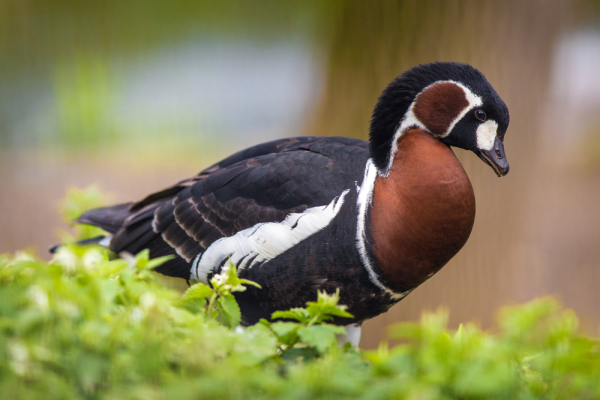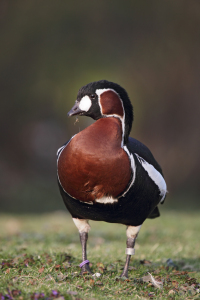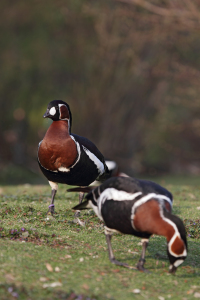
By: C.A. Victor
Considered the prettiest species of goose due to its vibrant coloration, the Red-Breasted Goose (Branta
ruficollis) is a small, distinctly colored bird that lives in the coastal regions of Europe and Asia. A member
of the genus Branta (or black geese), the species is one of the true geese and often hard to pick out from
a distance.

Characteristics
Like all members of the genus Branta, the Red-Breasted Goose has a dark, blackish coloring that is relieved
by white. White feather patterns almost look like striping in the case of this species. The unique aspect of
these geese is the large dark red patch along their throat and chest.
Apart from the obvious red-coloration of their throats, Red-Breasted Geese are small, stocky birds with a
small bill. They have a distinctive white stripe on their flank that becomes more obvious in flight. In
contrast, their underwings are all dark feathers. Unlike all other true geese species, they have also black
or very dark gray legs.
Geese are not sexually dimorphic, unlike many other bird species. Males and females of the species have
the same coloration and only slight size differences. Males are typically larger than females, with the Red-Breasted Goose this difference is even more slight.
What do Red-Breasted Geese Eat?
Like other members of the Branta genus, Red-Breasted Geese are herbivores. Most of their diet consists
of grass leaves and the shoots of cotton grasses while they are nesting. During the winter months, they
eat winter wheat, barley, maize, and even some pasture grasses. They’ll also eat some herbs if they find
them.
Where do Red-Breasted Geese live?
Red-Breasted Geese are a migratory Eurasian species. As waterfowl, they make their homes along
shorelines and some inland locations. During their breeding season, they nest in the northern regions of
Russia and the arctic European tundra. They are known to choose nesting sites near Peregrine Falcons and
Snowy Owls to provide protection from ground predators like the Arctic Fox. During the winter months, they
migrate south to the western shores of the Black Sea in Bulgaria and Romania. Occasionally, they have
been discovered in Great Britain and other European countries. They are also found frequently in captivity.
If spotted outside of their regular habitat, it is likely they are an escapee.

Red-Breasted Goose Facts
• Red-Breasted Geese get their scientific name from Branta (which is the Latinized form of the Old
Norse word meaning “burnt”) and ruficollis which is Latin for “red” (rufus) and “necked” (collis).
• They are the smallest species in genus Branta (and also smaller than genus Anser). Most of them
average between 52-56 cm (21-22in) in length and weigh around three pounds (1.36 kg).
• In the wild, red-breasted geese are considered vulnerable status by the International Union for
Conservation of Nature (IUCN).
• A 4,600-year-old tomb in Egypt depicts a duo of birds that may or may not be Red-Breasted Geese.
While these geese are similarly colored to the Red-Breasted Goose, scientists don’t know whether
they are a depiction of them or an extinct species. Given how far north these birds are located
today, it is an interesting question!
